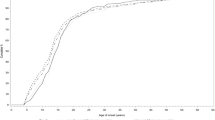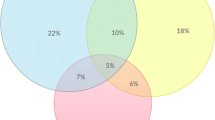Abstract
Purpose
The vast majority of studies investigating the association between social and psychological factors and anxiety disorders have been cross-sectional, making it difficult to draw causal conclusions. The purpose of the study was to investigate in a prospective longitudinal study whether social and psychological factors are associated with the later risk of being admitted to a hospital and receive a diagnosis of anxiety disorders.
Method
The study population comprised 4,497 members of The Copenhagen Perinatal Cohort (CPC) who in 1993 answered a mailed questionnaire containing questions on a range of social and psychological factors. In 2007, the study population was linked to The Danish Hospital Discharge Register and the Danish Psychiatric Central Register to obtain information on registration with anxiety disorders. Multiple Cox regression analysis was used to analyze the risk of anxiety disorders according to social and psychological factors.
Results
A total of 5.3% of the study population had lifetime registration with an anxiety disorder diagnosis. The risk of admission for anxiety disorders was significantly associated with previous: discontentedness with partner-status, loneliness, self-rated low intelligence, not feeling part of a whole, unhappiness, low quality of life, and low meaningfulness. Estimates were adjusted for income and current diseases.
Conclusion
The present study demonstrated that in a population without previous registration with anxiety disorders, contentment with social relations and a range of beneficial psychological factors reduced the later risk of being hospitalized with anxiety disorders.
Similar content being viewed by others
References
Gum AM, King-Kallimanis B, Kohn R (2009) Prevalence of mood, anxiety, and substance-abuse disorders for older Americans in the national comorbidity survey-replication. Am J Geriatr Psychiatry 17:769–781
Bekker MH (2007) Anxiety disorders: sex differences in prevalence, degree, and background, but gender-neutral treatment. Gend Med 4 (Suppl B):S178–S193
Griffin JM, Fuhrer R, Stansfeld SA, Marmot M (2002) The importance of low control at work and home on depression and anxiety: do these effects vary by gender and social class? Soc Sci Med 54:783–798
Kessler RC (1981) Trends in the relationship between sex and psychological distress: 1957–1976
Kessler RC, Berglund P, Demler O, Jin R, Merikangas KR, Walters EE (2005) Lifetime prevalence and age-of-onset distributions of DSM-IV disorders in the National Comorbidity Survey Replication. Arch Gen Psychiatry 62:593–602
de Graaf R, Ten Have M, van Gool C, van Dorsselaer S (2011) Prevalence of mental disorders and trends from 1996 to 2009. Results from the Netherlands Mental Health Survey and Incidence Study-2. Soc Psychiatry Psychiatr Epidemiol [Epub ahead of print]
Alonso J, Angermeyer MC, Bernert S, Bruffaerts R, Brugha TS, Bryson H et al (2004) Prevalence of mental disorders in Europe: results from the European Study of the Epidemiology of Mental Disorders (ESEMeD) project. Acta Psychiatr Scand Suppl 420:21–27
Bonnewyn A, Bruffaerts R, Vilagut G, Almansa J, Demyttenaere K (2007) Lifetime risk and age-of-onset of mental disorders in the Belgian general population. Soc Psychiatry Psychiatr Epidemiol 42:522–529
DuPont RL, Rice DP, Miller LS, Shiraki SS, Rowland CR, Harwood HJ (1996) Economic costs of anxiety disorders. Anxiety 2:167–172
Goetzel RZ, Hawkins K, Ozminkowski RJ, Wang S (2003) The health and productivity cost burden of the “top 10” physical and mental health conditions affecting six large US employers in 1999. J Occup Environ Med 45:5–14
Plaisier I, de Bruijn JG, Smit JH, de Graaf R, Ten Have M, Beekman AT et al (2008) Work and family roles and the association with depressive and anxiety disorders: differences between men and women. J Affect Disord 105:63–72
Rimehaug T, Wallander J (2010) Anxiety and depressive symptoms related to parenthood in a large Norwegian community sample: the HUNT2 study. Soc Psychiatry Psychiatr Epidemiol 45:713–721
Plaisier I, Beekman AT, de Bruijn JG, de Graaf R, Ten Have M, Smit JH et al (2008) The effect of social roles on mental health: a matter of quantity or quality? J Affect Disord 111:261–270
Wang JL, Lesage A, Schmitz N, Drapeau A (2008) The relationship between work stress and mental disorders in men and women: findings from a population-based study. J Epidemiol Community Health 62:42–47
Chang EC, Sanna LJ, Chang R, Bodem MR (2008) A preliminary look at loneliness as a moderator of the link between perfectionism and depressive and anxious symptoms in college students: does being lonely make perfectionistic strivings more distressing? Behav Res Ther 46:877–886
Moore D, Schultz NR (1983) Loneliness at adolescence––correlates, attributions, and coping. J Youth Adolesc 12:95–100
Eriksson M, Lindstrom B (2006) Antonovsky’s sense of coherence scale and the relation with health: a systematic review. J Epidemiol Community Health 60:376–381
Konttinen H, Haukkala A, Uutela A (2008) Comparing sense of coherence, depressive symptoms and anxiety, and their relationships with health in a population-based study. Soc Sci Med 66:2401–2412
Ristkari T, Sourander A, Ronning J, Helenius H (2006) Self-reported psychopathology, adaptive functioning and sense of coherence, and psychiatric diagnosis among young men––a population-based study. Soc Psychiatry Psychiatr Epidemiol 41:523–531
Ventegodt S, Henneberg E, Merrick J, Lindholt JS (2003) Validation of two global and generic quality of life questionnaires for population screening: SCREENQOL and SEQOL. Sci World J 3:412–421
Ventegodt S (1996) The quality of life of 4,500 31–33 year-olds. Result from a study of the prospective pediatric cohort of persons born at the University Hospital in Copenhagen (Partly in Danish). Forskningscentrets Forlag, Copenhagen
Jurgensen HJ, Frolund C, Gustafsen J, Mosbech H, Guldhammer B, Mosbech J (1986) Registration of diagnoses in the Danish national registry of patients. Methods Inf Med 25:158–164
Munk-Jørgensen P, Mortensen PB (1997) The Danish psychiatric central register. Dan Med Bull 44:82–84
Juel K, Helweg-Larsen K (1999) The Danish registers of causes of death. Dan Med Bull 46:354–357
Durkheim E (1952) Suicide. Routledge and Kegan Paul, London
Horwitz AV, White HR (1991) Becoming married, depression, and alcohol problems among young adults. J Health Soc Behav 32:221–237
Pearlin LI, Johnson JS (1977) Marital status, life-strains and depression. Am Sociol Rev 42:704–715
Gove WR, Hughes M, Style CB (1983) Does marriage have positive effects on the psychological well-being of the individual? J Health Soc Behav 24:122–131
Mirowsky J, Ross CE (1989) Social causes of psychological distress. Aldine de Gruyter, New York
Falk Dahl CA, Dahl AA (2010) Lifestyle and social network in individuals with high level of social phobia/anxiety symptoms: a community-based study. Soc Psychiatry Psychiatr Epidemiol 45:309–317
Barnett RC (1992) Job experiences over time, multiple roles, and women’s mental health: a longitudinal study. J Pers Soc Psychol 62:634–644
Fergusson DM, Horwood LJ, Ridder EM (2005) Show me the child at seven II: childhood intelligence and later outcomes in adolescence and young adulthood. J Child Psychol Psychiatry 46:850–858
Koenen KC, Moffitt TE, Roberts AL, Martin LT, Kubzansky L, Harrington H et al (2009) Childhood IQ and adult mental disorders: a test of the cognitive reserve hypothesis. Am J Psychiatry 166:50–57
Martin LT, Kubzansky LD, LeWinn KZ, Lipsitt LP, Satz P, Buka SL (2007) Childhood cognitive performance and risk of generalized anxiety disorder. Int J Epidemiol 36:769–775
Fontaine RG, Yang C, Burks VS, Dodge KA, Price JM, Pettit GS et al (2009) Loneliness as a partial mediator of the relation between low social preference in childhood and anxious/depressed symptoms in adolescence. Dev Psychopathol 21:479–491
Jackson J, Cochran SD (1991) Loneliness and psychological distress. J Psychol 125:257–262
Russell D, Peplau LA, Cutrona CE (1980) The revised UCLA Loneliness Scale: concurrent and discriminant validity evidence. J Pers Soc Psychol 39:472–480
Antonovsky A (1987) Unravelling the mystery of health. How people manage stress and stay well. Jossey-Bass, San Francisco
Mendlowicz MV, Stein MB (2000) Quality of life in individuals with anxiety disorders. Am J Psychiatry 157:669–682
Olatunji BO, Cisler JM, Tolin DF (2007) Quality of life in the anxiety disorders: a meta-analytic review. Clin Psychol Rev 27:572–581
Bruffaerts R, Bonnewyn A, Demyttenaere K (2007) Delays in seeking treatment for mental disorders in the Belgian general population. Soc Psychiatry Psychiatr Epidemiol 42:937–944
Lahey BB (2009) Public health significance of neuroticism. Am Psychol 64:241–256
Acknowledgments
This study was supported by a research grant from the IMK Almene Fond. The Danish Quality of Life Survey was supported by grants from the 1991 Pharmacy Foundation, the Goodwill-fonden, the JL-Foundation, E. Danielsen and Wife’s Foundation, Emmerick Meyer’s Trust, the Frimodt-Heineken Foundation, the Hede Nielsen Family Foundation, Petrus Andersens Fond, Wholesaler C.P. Frederiksens Study Trust, Else & Mogens Wedell-Wedellsborg’s Foundation and IMK Almene Fond.
Conflict of interest
None.
Author information
Authors and Affiliations
Corresponding author
Electronic supplementary material
Below is the link to the electronic supplementary material.
Rights and permissions
About this article
Cite this article
Flensborg-Madsen, T., Tolstrup, J., Sørensen, H.J. et al. Social and psychological predictors of onset of anxiety disorders: results from a large prospective cohort study. Soc Psychiatry Psychiatr Epidemiol 47, 711–721 (2012). https://doi.org/10.1007/s00127-011-0373-9
Received:
Accepted:
Published:
Issue Date:
DOI: https://doi.org/10.1007/s00127-011-0373-9




